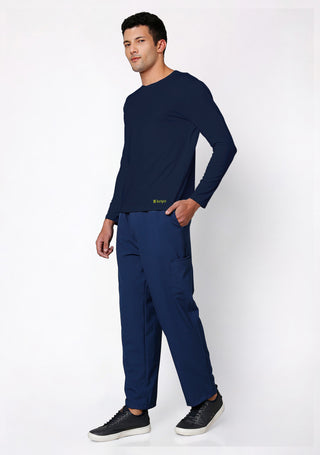Lab coats have transcended their traditional role in hospitals and research labs to become a staple in numerous industries. Whether in food processing, forensic science, art conservation, or electronics manufacturing, these garments serve as vital protective gear while also symbolizing professionalism and expertise.
As industries evolve, so will the design and functionality of lab coats, ensuring they remain an essential part of various work environments. The next time you see someone in a lab coat, remember they might not be a doctor or scientist but could be working in a field you never expected!
The Symbol of Protection: Why Lab Coats Matter
Lab coats are more than just a uniform; they serve as a critical barrier between professionals and hazardous substances. Made from materials ranging from lightweight cotton to fire-resistant synthetic blends, lab coats are designed to shield the wearer from spills, splashes, dust, and even biological contaminants.
Key functions of lab coats include:
- Protection against chemical spills and hazardous substances.
- Prevention of cross-contamination between workspaces.
- Serving as a visual identifier for professionals in specific fields.
- Providing pockets and storage for essential tools and documents.
With these benefits in mind, let’s explore industries where lab coats play a crucial role beyond the medical and pharmaceutical sectors.
Lab Coats in Chemical and Manufacturing Industries
Chemical Laboratories
In the chemical industry, safety is paramount. Chemists and chemical engineers work with volatile substances that can cause burns, reactions, or contamination. Lab coats in these settings are often flame-resistant and chemical-proof, ensuring that workers are safeguarded against potential hazards. Some coats are even designed to be anti-static, reducing the risk of accidental ignitions in explosive environments.
Manufacturing and Quality Control
Manufacturing industries, particularly those involved in producing pharmaceuticals, cosmetics, or specialty chemicals, require strict quality control measures. Lab coats help maintain hygiene and prevent contaminants from compromising production batches. Workers in these settings wear lab coats to ensure that their clothing does not introduce unwanted particles into sensitive production lines.
Shop the Best Lab Coats from Here!
Food Industry: Hygiene and Safety in Food Processing
The food industry is another field where lab coats play an essential role. In food processing plants, hygiene is critical to prevent contamination and ensure product safety. Workers in these facilities wear white lab coats to maintain a clean and controlled environment.
Key reasons for using lab coats in the food industry include:
- Preventing cross-contamination between different food products.
- Ensuring compliance with hygiene regulations set by food safety authorities.
- Protecting workers from spills, hot surfaces, and sharp objects.
Lab coats in food processing are often made of lightweight, easily washable fabrics to ensure cleanliness. Some are even disposable to minimize contamination risks.
Lab Coats in Forensic Science and Crime Investigation
Forensic experts and crime scene investigators rely on lab coats as part of their protective gear. When analyzing evidence in a lab or working at crime scenes, forensic professionals must avoid contaminating samples with their own clothing or biological materials.
Lab coats in forensic science serve to:
- Prevent contamination of crucial evidence.
- Protect forensic scientists from harmful biological agents.
- Maintain a professional and standardized appearance in crime laboratories.
These coats are often paired with gloves, masks, and goggles to ensure the highest levels of safety and accuracy during investigations.
Art Conservation and Restoration: Protecting Masterpieces
While the worlds of science and art may seem far apart, lab coats have found a place in art conservation and restoration. Professionals in this field work with delicate paintings, sculptures, and historical artifacts, often handling chemicals, solvents, and fragile materials.
Lab coats help in:
- Protecting artwork from contaminants like dust, oils, and fibers from clothing.
- Shielding conservators from the harmful effects of solvents and cleaning agents.
- Creating a professional and standardized work environment in restoration studios.
In art conservation, lab coats are usually white to highlight any dirt or stains that might transfer to an artwork, ensuring that they remain clean while working on valuable pieces.
Agriculture and Veterinary Science: Keeping It Clean
Agricultural researchers and veterinarians also rely on lab coats in their daily work. In agricultural research, professionals handle soil, plants, and chemicals used in pest control, making lab coats an essential part of their protective gear.
For veterinarians, lab coats serve as a protective barrier against animal hair, bodily fluids, and potential zoonotic diseases. A clean and well-maintained lab coat not only provides protection but also instills confidence in pet owners and farm workers.
Specialized lab coats in these fields may be designed with additional pockets to carry small tools, thermometers, and syringes, making them practical for fieldwork.
Electronics and Semiconductor Industry: Anti-Static Lab Coats
In high-tech industries like electronics manufacturing and semiconductor fabrication, static electricity can damage sensitive components. To prevent this, professionals wear anti-static lab coats made from conductive materials that help dissipate electrostatic charges.
Benefits of lab coats in electronics and semiconductor industries:
- Preventing static discharge that could damage microchips.
- Maintaining cleanroom environments by reducing dust and fiber shedding.
- Providing a professional and uniform appearance in precision-focused industries.
These lab coats are often part of a broader cleanroom attire that includes gloves, hairnets, and boot covers to maintain a dust-free environment.
Browse best Scrubs Collection
The Evolving Fashion and Personalization of Lab Coats
As lab coats continue to expand into different industries, customization and style have also become important. Companies and professionals now personalize their lab coats with embroidered names, logos, and even tailored fits.
Some trends in lab coat customization include:
- Color Coding: Different colors signify different roles (e.g., white for lab personnel, blue for manufacturing workers).
- Fitted Designs: Modern lab coats are designed for both comfort and aesthetics.
- Sustainable Materials: Eco-friendly lab coats made from recycled fibers are gaining popularity.
This shift towards personalized and stylish lab coats helps create a sense of belonging and pride in various professions.













